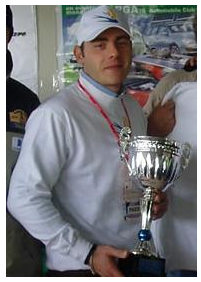eProLab
DIMEC - Dept. of Mech. Engin.
University of Salerno
84084 Fisciano (Salerno), Italy
Ph. +39 089 964239
FAX +39 089 964037
 | rdimartino@unisa.it |

Name: Raffaele Di Martino; Date of birth: 17.12.1980; Home Address: Pellezzano (SA)
Telephone: +39 331 793 852 2 and +39 320 574 271 0
e-mail: rdimartino@unisa.it
Marital Status: Single
Nazionality: Italian
Place of birth: Salerno (Sa)
Exempt from Military Service
INTERESTS and EXPECTATIONS
ŌĆó To improve my knowledge about static/dynamic modelling
ŌĆó To implement calculation models concerning the automotive field
EDUCATION and QUALIFICATIONS
1998 Giugno. Scientific High School Diploma "Liceo Scientifico Leonardo da Vinci"- Salerno.
2004 Settembre ŌĆō 2005 Marzo. Degree Scholarship for Erasmus/Socrates Program in the MIPS Laboratory (Mod├®lisastion Intelligence Processus Syst├©mes), ŌĆ£Universit├® de Haute AlsaceŌĆØ, Mulhouse, France.
2005 Aprile. Degree in Mechanical Engineering, University of Salerno, Italy. Thesis written in english language with title: ŌĆ£Modelling and Simulation of the Dynamic Behaviour of the AutomobileŌĆØ. Tutor: Prof. Gianfranco Rizzo. Co-Tutors: Prof. G├®rard Gissinger, Dott. Ing. Ivan Arsie.
2005 Novembre ŌĆō Italian State Exam to obtain the professional qualification to practice as an engineer at ŌĆ£Albo degli Ingegneri della Provincia di SalernoŌĆØ.
SCIENTIFIC WORK
Collaboration at Leonardo Project - "Energy Conversion Systems and Their Environmental Impact" on Hybrid Solar Vehicles
Collaboration for the 62┬░ Congresso ATI, ŌĆ£Associazione Termotecnica ItalianaŌĆØ, University of Salerno, Italy.
Collaboration for "1st and 2nd International Workshop on Hybrid and Solar Vehicles", University of Salerno, Italy.
CURRENT OCCUPATION
PdD in the eProLab - Energy and Propulsion Laboratory at the Department of Mechanical Engineering of University of Salerno, Italy.
LANGUAGES
Italian: mother tongue
French: basics
English: Fluent
COMPUTER KNOWLEDGMENT
MS Windows Platforms: optimal
Desktop publishing: MS Office et all.
Numerical Computations: Mathematica, Matlab and Simulink.
CAD Tools: AutoCAD, ArchiCAD.
CAE Tools: Soft.Lab IperSpace, mc4 Hvac.
Web publishing: Frontpage et al.
Programming: Autolisp, VisualLisp, C++.
HOBBIES
Horse-riding and ski
Reading (classic)
Conference papers | |
2008 |
|
2007 |
|
2006 |
|



